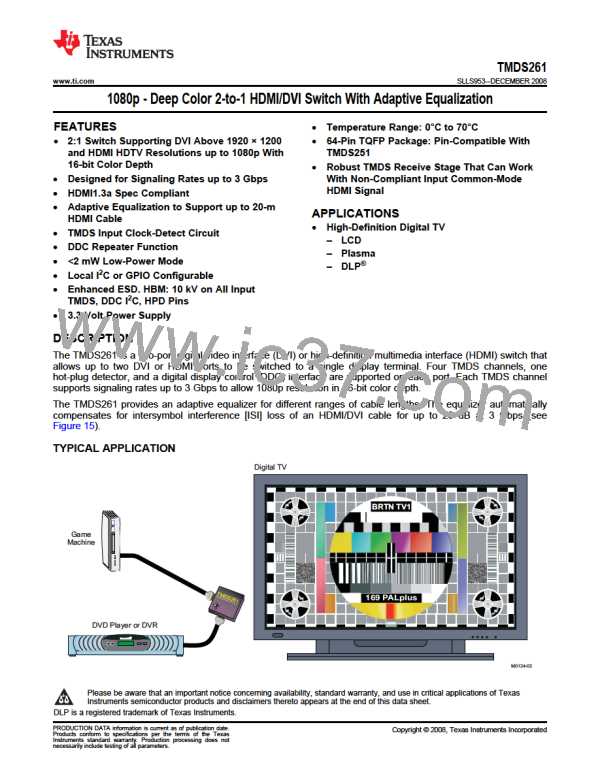TMDS261
SLLS953–DECEMBER 2008............................................................................................................................................................................................ www.ti.com
Table 7. TMDS261 Slave Address
FIXED ADDRESS
READ/WRITE BIT
Bit 0 (R/W)
1/0
Bit 7 (MSB)
Bit 6
Bit 5
Bit 4
Bit 3
Bit 2
Bit 1
0
1
0
1
1
0
0
EXAMPLE – WRITING TO THE TMDS261
The proper way to write to the TMDS261 is illustrated as follows:
An I2C master initiates a write operation to the TMDS261 by generating a start condition (S) followed by the
TMDS261 I2C address (as shown following, in MSB-first bit order, followed by a 0 to indicate a write cycle. After
receiving an acknowledge from the TMDS261, the master presents the subaddress (sink port) to be written,
consisting of one byte of data, MSB-first. The TMDS261 acknowledges the byte after completion of the transfer.
Finally, the master presents the data to be written to the register (sink port), and the TMDS261 acknowledges the
byte. The master can continue presenting data to be written after TMDS261 acknowledges the previous byte
(steps 6, 7). After the last byte to be written has been acknowledged by TMDS261, the I2C master then
terminates the write operation by generating a stop condition (P).
Step 1
0
I2C start (master)
S
Step 2
7
6
5
4
3
2
1
0
I2C general address (master)
0
1
0
1
1
0
0
0
Step 3
8
I2C acknowledge (slave)
A
Step 4
7
6
5
4
3
2
1
0
I2C write sink logic address (master)
0
0
0
0
Addr
Addr
Addr
Addr
Step 5
8
I2C acknowledge (slave)
A
Step 6
7
6
5
4
3
2
1
0
I2C write data (master)
Data
Data
Data
Data
Data
Data
Data
Data
Data is the register address or register data to be written
Step 7
8
I2C acknowledge (slave)
A
Step 8
0
I2C stop (master)
P
An example of the proper bit control for selecting port 2 is:
Step 4: 0000 0001
Step 6: 1001 0000
EXAMPLE – READING FROM THE TMDS261
The read operation consists of two phases. The first phase is the address phase. In this phase, an I2C master
initiates a write operation to the TMDS261 by generating a start condition (S) followed by the TMDS261 I2C
address, in MSB-first bit order, followed by a 0 to indicate a write cycle. After receiving acknowledges from the
TMDS261, the master presents the subaddress of the register to be read. After the cycle is acknowledged (A),
the master may optionally terminate the cycle by generating a stop condition (P).
The second phase is the data phase. In this phase, an I2C master initiates a read operation to the TMDS261 by
34
Submit Documentation Feedback
Copyright © 2008, Texas Instruments Incorporated
Product Folder Link(s) :TMDS261

 TI [ TEXAS INSTRUMENTS ]
TI [ TEXAS INSTRUMENTS ]